Understanding Used Kiteboard Equipment: Key Insights
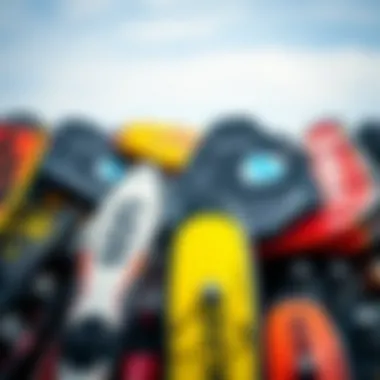
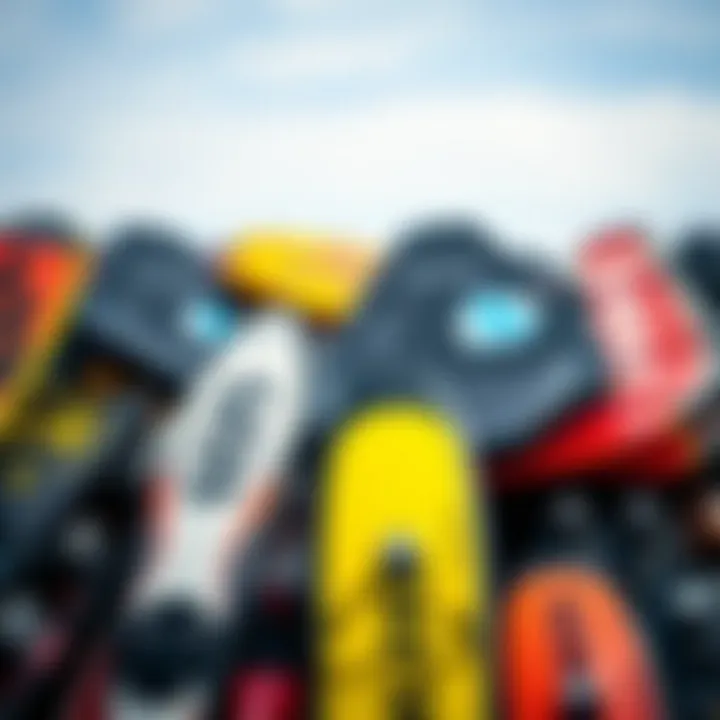
Intro
The world of kiteboarding is vast, with its own set of equipment complexities and nuances. For both novices and seasoned pros, understanding what used gear to invest in can be a bit of a minefield. As kiteboarding becomes more popular, exploring the second-hand market has gained significant traction. Not only can buying used equipment be cost-effective, but it can also lead to finding unique pieces that have character and serve their purpose without breaking the bank. But what should one consider when diving into this market? In this article, we will unpack crucial insights into buying used kiteboard gear, focusing on key aspects like performance, maintenance, and potential pitfalls a buyer might encounter.
Gear and Equipment
When it comes to kiteboarding, having the right gear is half the battle. This section will break down essential gear for newcomers and some advanced options for the experienced riders.
Essential Kiteboarding Gear for Beginners
For those just dipping their toes in the water, several pieces of equipment are essential to get started. First off, every beginner needs a reliable kite. A medium-sized kite is good for most conditions, allowing new riders to have some versatility. Brands like Naish and Ozone are popular among newbies looking for durable kites that balance performance and stability.
Next on the list is a sturdy board. Beginners should focus on a larger board, which provides a more stable platform for learning. A twin-tip board is often suggested since it allows for easier transitions regardless of wind direction.
Also, safety equipment like a helmet and impact vest is crucial. Safety must come first, especially for those who are just learning how to navigate the open waters and crunchy shorelines.
Finally, consider a control bar. The control bar connects the kite to the rider via lines. Look for a used control bar that is undamaged and operational, as this is critical for safety and control.
Advanced Equipment for Experienced Riders
For those who have mastered basic skills and want to take things to the next level, exploring advanced equipment can lead to significant performance improvements. Experienced kiteboarders often look for more specialized kites tailored for specific winds or conditions. For instance, variations like wave kites or freestyle kites can offer more responsiveness and maneuverability.
Another consideration is the board size and shape. While beginners may favor larger boards, advanced riders might opt for smaller, lighter boards designed for speed and tricks. Boards made from high-quality materials can withstand more stress and last longer.
Lastly, experienced kiteboarders should be familiar with foot straps. Some prefer foot straps for enhanced control, while others may opt for bindings for a more locked-in feeling. Depending on your riding style, choosing the right option becomes critical for performance.
Techniques and Tips
Understanding your equipment is key, but mastering its use is where the real fun begins. This section outlines basic techniques for newcomers, as well as tips for seasoned riders looking to push their limits.
Basic Riding Techniques for Newbies
When you're beginning your kiteboarding journey, practice is paramount. Start by getting a feel for the kite on land. Learning how to control the kite's movement through the air will significantly increase your comfort level before hitting the water.
Once you're in the water, focus on your starting stance. Keep your knees slightly bent and shift your weight effectively to start riding. Remember to maintain tension in the lines as you go.
A common mistake beginners make is overbearing the kite. Focus on using small, gentle inputs. The kite responds to even slight movements, and excessive force can cause accidents.
Expert Tricks to Elevate Your Skills
As you gain confidence in riding, you might be tempted to try aerial tricks or jumps. Before jumping, make sure you have solid control over your kite. The key to successful jumping lies in timing and understanding the conditions.
Some advanced riders enjoy practicing tricks like downwinders and hydrofoiling. These require finesse and knowledge of the wind and water conditions. It's wise to have a trainer or mentor assist with these techniques to ensure safety and success.
Remember, kiteboarding is about progression; don’t rush through learning the essential techniques, as the foundation will only benefit you as you learn to master the sport.
Epilogue
Navigating the used kiteboard equipment market can seem daunting, but with the right insights and considerations, you can make informed decisions that enhance your kiteboarding experience. By selecting the right gear for your skill level, understanding various techniques, and maintaining your equipment effectively, you can get the most out of your time on the water. For more discussions on practical kiteboarding gear and experiences, check out forums on platforms such as Reddit or join local groups on Facebook.
For resources on kiteboarding certifications and safety equipment, visit
IKO or the Kiteboarding Association.
Explore your options wisely and enjoy the thrill that kiteboarding offers.
Intro to Used Kiteboard Equipment
Diving into the world of used kiteboard equipment can be both thrilling and daunting. For those keen to embrace the exhilarating sport of kiteboarding, understanding the nuances of used gear is vital. This segment lays the groundwork for evaluating various pieces of second-hand equipment and highlights why focusing on used gear can be both a smart financial decision and a step towards a more sustainable approach to kitesurfing.
Understanding Kiteboarding Equipment
Kiteboarding equipment is more than just a collection of items; it’s a blend of advanced technology and personal preference, shaped by the rider's style and experience level. Familiarizing oneself with the essentials begins with grasping core components – kites, boards, bindings, harnesses, and control bars. Each element plays a crucial role in performance and safety.
A kite's design, for instance, greatly influences how it interacts with the wind. Whether one opts for a flat or bow kite can affect not just performance but also comfort. Boards come in different shapes and sizes, impacting everything from speed to maneuverability. Understanding these variables is paramount, especially when considering buying used.
The Appeal of Used Gear
There’s a certain charm that comes with purchasing used gear. For starters, the financial aspect is hard to ignore. Used kiteboarding equipment is typically priced significantly lower than new items. This affordability opens the door for newcomers to the sport who may not want to splurge right out of the gate.
Moreover, choosing used gear can mitigate environmental impacts. The use of second-hand equipment extends the lifecycle of products, highlighting a commitment to sustainability. Rather than rushing to buy new and contributing to waste, kiteboarders can give existing gear a second lease on life, benefiting both their wallet and the environment.
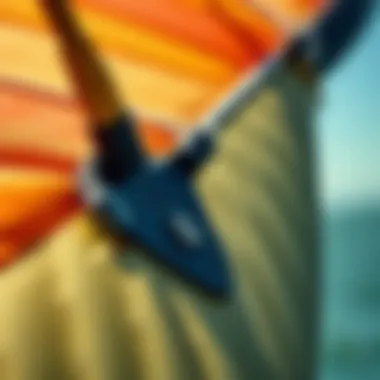
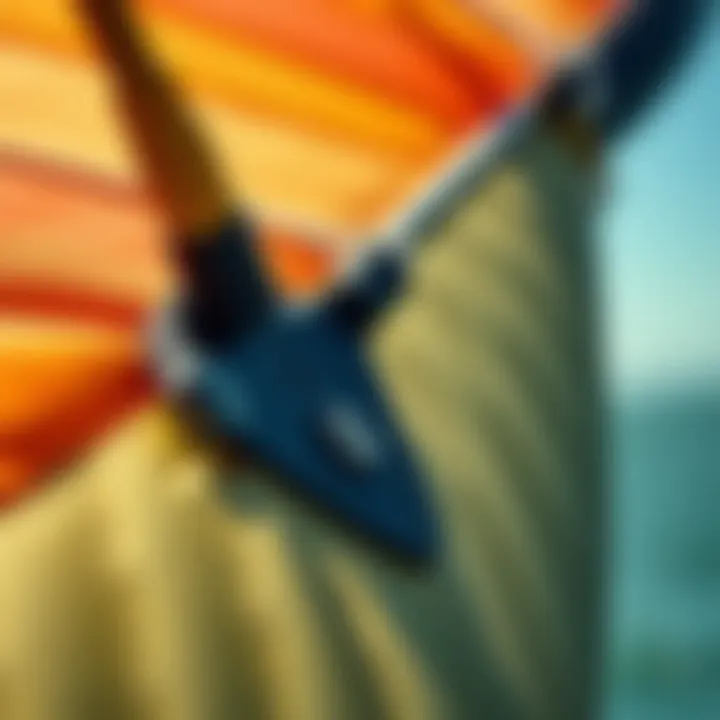
"Buying used isn’t just about saving money; it’s about making a choice for the planet too."
Lastly, purchasing used allows for the opportunity to test different styles and pieces of equipment without the same level of investment usually required for new gear. This aspect of experimentation can be particularly fulfilling for more seasoned riders looking to refine their setup. Plus, with so many used options available, from local classifieds to dedicated kiteboarding forums on platforms like Reddit, the possibilities become nearly endless.
Types of Used Kiteboard Equipment
In the dynamic world of kiteboarding, the type of equipment you choose can make or break your experience on the water. Used kiteboard gear comes with its own set of varieties, each designed with specific purposes in mind. Looking into types of used kiteboard equipment becomes essential, especially for those who are conscious about both budget and performance. Understanding what’s out there is akin to knowing the lay of the land before embarking on an adventure. It can guide novice and seasoned riders in their quest for the perfect setup; what can be more exhilarating than finding just the right kite?
Kite Options
Different Kite Designs
Diving into the world of kite designs, you’ll find that each design brings a unique flair and feel to your riding. For instance, the difference between delta and bow kites lies not just in appearance but in performance as well. Delta kites are known for their excellent upwind capabilities and stability in gusty conditions, making them a favorite among beginners. On the other hand, bow kites offer immense power and larger wind range, which experienced riders might favor. So, whether you’re catching the wind in light breezes or powering through stronger gusts, the right kite design makes all the difference.
Size Variations
Size matters—at least when it comes to kites. A kite’s size will dictate how it performs in various wind conditions. Smaller kites pack a punch in strong winds, giving you agility and control. Larger kites, in contrast, thrive in lighter winds, allowing you to float and glide smoothly. For those who purchase used equipment, knowing the size you need based on your weight and riding skill can be key. The unique feature of kite sizes is that they cater to a broad spectrum of riding styles and personal preferences.
Material Durability
When it comes to materials, durability stands as a crucial factor for kite longevity. Most kites these days are made of ripstop nylon or polyester, both of which enhance durability, but age and use can impact performance. So, for someone considering used equipment, understanding the material composition can save heartache down the line. Old kites made with heavier materials might resist wear but sacrifice performance. When hunting for the perfect used kite, keep an eye out for any fraying or signs of wear which could indicate a decline in durability.
Boards
Board Shapes and Their Impact
Much like kites, the shape of the board influences handling and responsiveness. For instance, boards with a significant rocker shape offer smoother rides in chop, while flatter boards could give you more speed and better upwind capability. When exploring second-hand options, a board's shape could be a decisive factor in your overall riding experience. Checking the board's design can unveil how it will handle the water, so make sure to take a good look before making that purchase.
Performance Considerations
For performance-focused kiteboarders, pondering over how board dimensions—like length and width—can affect overall skill and style of riding is critical. A wider board tends to provide better planing ability, allowing the rider to grip the water tightly while gliding with ease. Yet, it can also feel less nimble. Conversely, thinner boards lend themselves to tricks for more skilled riders but can compromise stability in tricky winds. Understanding these factors ahead of time can really help hone in on what type of board you plan to ride.
Material Composition
The materials used in board construction have advanced significantly. From foam core to different types of fiberglass, these choices can make or break the board's performance at a deeper level. For example, boards made from lighter materials may enhance speed but lack the rigidity needed for advanced tricks. Weighing the pros and cons in terms of weight vs. stiffness is crucial when searching for used boards.
Bindings and Harnesses
Types of Bindings
Bindings are what attach your feet to your board, making understanding the different types crucial. Strap bindings, for instance, provide versatility for different foot sizes but may lack the tight fit that some riders prefer. Fixed bindings often deliver the precise control needed for advanced maneuvers. As you sort through used gear, reflect on your own riding style—what works wonders for one may simply not fit the bill for another.
Choosing the Right Harness
An appropriate harness is equally vital; it’s what connects you to the kite. Reading up on the different styles—seat, waist, or even hybrid harnesses—can really help you narrow down options based on comfort and performance. For instance, a waist harness gives you excellent freedom for tricks, while a seat harness offers more support for beginners. As always, comfort is key, especially when out on the water for extended periods.
Importance of Comfort and Fit
The importance of comfort and fit cannot be overstated. A well-fitting harness can mean the differenc e between a day of enjoyment and one filled with ache. Additionally, the fit can aid in performance, as a comfortable harness ensures that you can focus on riding rather than adjusting your gear. When scouting used harnesses, be sure to try things on and listen to what your body is telling you.
Control Bars and Lines
Bar Sizes and Their Effects
Just like kites and boards, the size of the control bar affects how you interact with your kite. A shorter bar offers quicker movements, beneficial in tight situations or for tricks, while a longer bar can provide a broader range with more control but may feel ungainly to some. Dive into the options available, and think about what you want your experience to be like when you’re on the water.
Line Quality Assessment
Line quality can be a make-or-break factor in performance. Thick, durable lines can withstand the test of time but may lack the responsiveness of thinner lines, which can lead to improved handling. As you check out used equipment, look for any signs of wear on the lines—a fraying line can lead to serious safety issues that no one wants to deal with while riding.
Role of Depower Systems
The incorporation of depower systems has revolutionized the way kiteboarders manage power in their rides. These systems allow riders to quickly engage or disengage the kite’s pull. A good depower system can give you peace of mind in varying wind conditions, but understanding its mechanics is essential for effective use. When assessing used gear, make sure the depower system is functioning correctly to avoid unexpected surprises on the water.
Benefits of Purchasing Used Kiteboarding Gear
In the competitive world of kiteboarding, selecting the right gear can have a significant impact on your overall experience. Purchasing used kiteboarding equipment offers multiple advantages that can appeal to both newcomers and seasoned enthusiasts. Not only is it a savvy financial decision, but it’s also a stride toward sustainability and an avenue for hands-on experimentation. Let's explore these significant facets more closely.
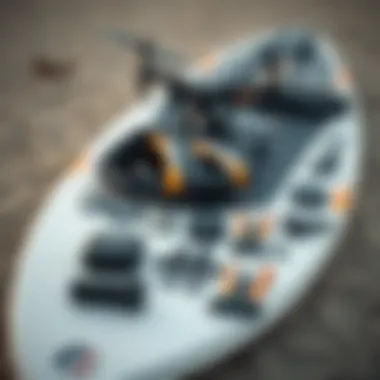
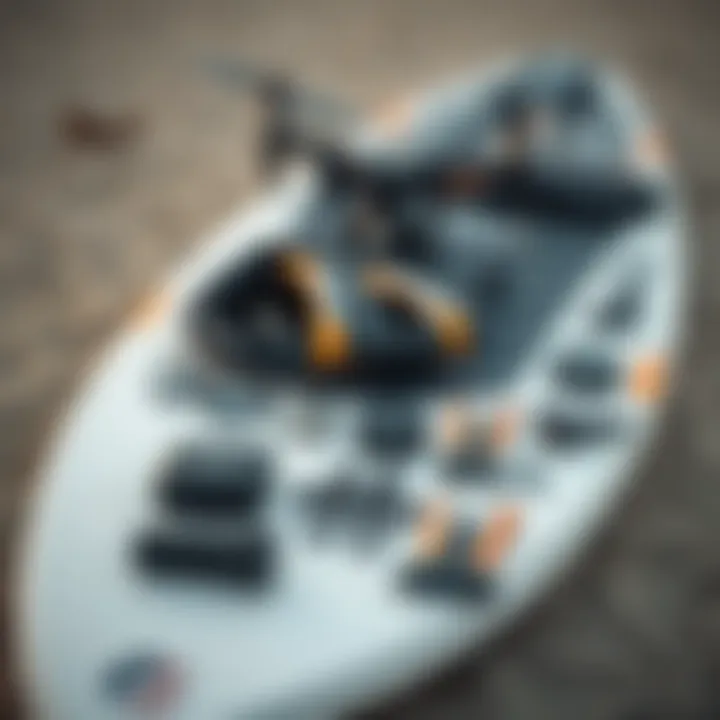
Cost-Effectiveness
When diving into the realm of kiteboarding gear, one of the most glaring benefits of buying used equipment is, without question, the cost-effectiveness. New kiteboards, kites, and related equipment can leave a serious dent in your wallet, sometimes reaching thousands of dollars. In contrast, opting for pre-owned gear can save you anywhere from 30% to 60% of the original price.
For example, a brand-new Slingshot Rally kite might retail for around $1,300, while a used model, if well-maintained, could be snagged for approximately $700. This substantial difference not only makes the sport more accessible but also allows you to allocate funds toward lessons or travel expenses to enjoy kiteboarding at stunning locations.
"Why spend big when you can get the same thrill for less?"
Sustainability Factors
Purchasing used kiteboarding gear also holds significant environmental sway. As sustainable practices take root in various industries, kiteboarding is not lagging behind. When you buy second-hand equipment, you contribute to a circular economy that promotes recycling and reusing material, reducing the need for new, resource-intensive production.
A kiteboard can take a considerable amount of energy to manufacture given the materials involved, especially composites that might not break down easily. By opting for used gear, you help prolong the lifespan of these products and minimize waste in landfills. Choosing sustainability can lead to cleaner oceans and beaches, ensuring that the places we kiteboard remain pristine for future generations. After all, isn’t it our responsibility to take care of the lovely spots we enjoy?
Opportunity for Experimentation
Buying used kiteboarding equipment presents an excellent opportunity for experimentation. When you venture into the market for second-hand gear, you often find a wider variety of styles and options, some of which may not be readily available in stores anymore. This opens the door for trying out different board shapes, sizes, and kite designs without breaking the bank.
Imagine getting to test a 2015 Cabrinha Switchblade or an older North Rebel without shelling out a fortune. If you discover that a specific style suits your riding technique or personal preferences, purchasing used allows for lower stakes – if you don’t love it, you haven’t invested a fortune into it. Moreover, this variability can enhance your skill set as you adapt to differing equipment, making you a more versatile kiteboarder in the long run.
In summary, the benefits of purchasing used kiteboarding gear go beyond mere financial savings. Emphasizing sustainability and offering unique chances for experimentation, it’s a practice that resonates with the community’s core values. Whether you’re just starting or well into your kiteboarding journey, taking the plunge into the second-hand market might be the smartest move you'll ever make.
For more information on gear maintenance and how to select the right equipment, visit Wikipedia or join discussions on Reddit.
Remember, being informed and meticulous in your choices can lead to rewarding experiences on the water.
Challenges When Buying Used Equipment
When it comes to acquiring used kiteboarding gear, navigating the landscape can feel like trying to ride a wave with the wrong board. There are certain hurdles one must be aware of to make a sound decision. Understanding the challenges of purchasing used equipment is crucial for ensuring both satisfaction and safety on the water.
Quality Assurance
The first challenge that often rears its head is quality assurance. Unlike new equipment that comes with guarantees and warranties, used gear can be a bit of a gamble. Here are a few key points to consider:
- Inspect Before You Buy: Always request the history of the gear to determine how it was used. Lifespan, frequency of use, and previous repairs can indicate how well it has held up.
- Research Brands: Some brands are known for better durability and craftsmanship. Familiarizing yourself with reputable manufacturers can save you from poor investments.
- Check Reviews: Online forums and review sites can provide you with insights from other users. Feedback on specific models or types of equipment can shed light on which have a longer lifespan.
Improperly maintained gear can lead to disappointments, or worse, accidents. As such, ensuring the equipment’s quality is non-negotiable.
Potential for Hidden Damages
Buying used gear often comes with the risk of hidden damages that might not be immediately visible. These issues can be critical, as they can turn a thrilling kiteboarding session into a terrifying ordeal.
- Physical Inspection: Look closely for wear and tear, especially in areas that are heavily stressed, like the seams of kites or the edges of boards. Small scratches and nicks can hint at larger issues under the surface.
- Ask Questions: Inquire if the seller has ever repaired the item, or if they have had any significant accidents while using it.
- Look for Warranty or Returns: If the seller can provide limited warranties or allow for returns, it can offer you a safety net against unseen damages.
Remember, just like peeling the layers off an onion, sometimes one has to dig deep to uncover concealed troubles.
Outdated Technology
The final challenge is the possibility of outdated technology. Kiteboarding equipment evolves quickly, and what was state-of-the-art just a few years ago may not compete with modern standards. Here’s why it matters:
- Performance Benefits: Newer models often come with design improvements that enhance performance and safety. For example, control bars have evolved dramatically to offer better response times.
- Compatibility Issues: If you're thinking of purchasing used gear to combine with newer components, it’s crucial to ensure they work together seamlessly.
- Future Proofing: Consider how long you expect to use the equipment. Investing in outdated tech might mean you’ll have to upgrade sooner than you’d like, negating the savings of buying used.
"It's not just about finding a deal; it’s about getting the right fit for your kiteboarding journey."
Always be cautious and informed when approaching the used gear market. The challenges you face can determine whether your kiteboarding experience soars or stalls.
Key Considerations for Purchasing Used Kiteboard Gear
When it comes to buying used kiteboard equipment, there are several key considerations that can significantly impact your experience on the water. Understanding these factors can help you avoid missteps and help you make a purchase that aligns with your needs and riding style.
Researching Gear History
Researching the history of used gear before purchasing is paramount. Knowing how the equipment was used in its past can reveal insights into its durability and reliability. Some gear may have been well-cared for, while others might have experienced rough treatment, leading to potential weaknesses. This involves asking the seller about the gear's history, which includes details on how long they’ve used it, the conditions it was used in, and if any repairs have been made.
Gathering this kind of information not only informs you about what you’re buying but can also make or break the deal. A board or kite that’s been lovingly maintained is more likely to provide joy and safety, compared to one that’s been neglected.
Inspection Techniques
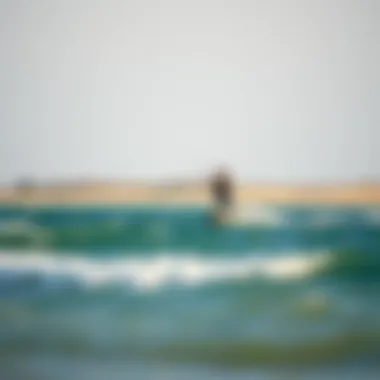
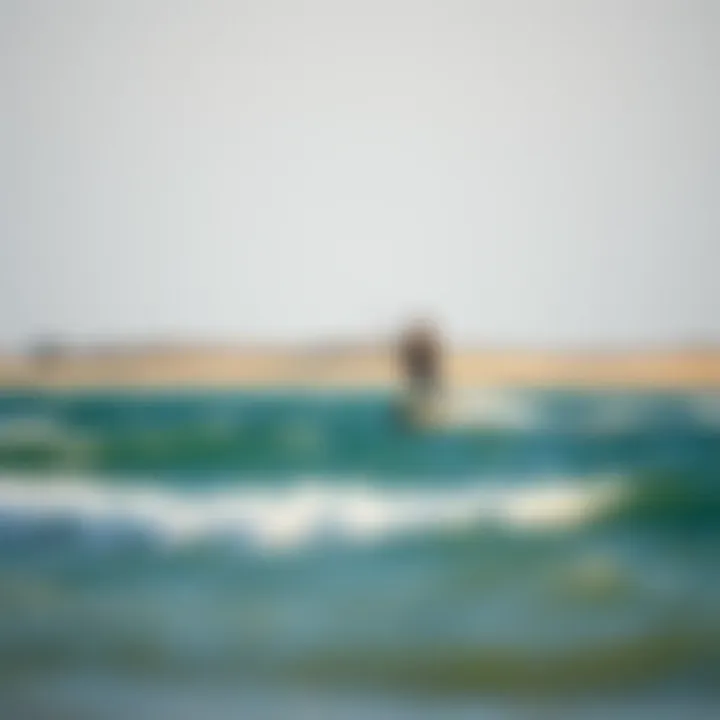
To ensure that you’re getting a solid piece of equipment, applying some inspection techniques is essential. You don’t want to gamble with your safety or your wallet. Here are some tried and tested methods:
Visual Checks
Visual checks are the first line of defense when assessing condition. This involves combing over the gear for any visible signs of wear and tear. Look for scratches, punctures, or frayed lines. A clean visual inspection can save you a headache later. Focus on the kite’s leading edge and stitching, as well as the board's underside.
The neat characteristic of visual checks is that they give you instant feedback. However, they don’t always reveal internal damage or performance issues, which leads you to further inspections.
Functional Tests
Functional tests assess whether the equipment actually performs as expected. This may mean checking if the inflate/deflate system works smoothly, or if the control bar responds accurately. These tests highlight performance capabilities in real-time scenarios.
You would usually inflate the kite fully, checking that it retains pressure without any leaks. While functional tests can be a bit taxing, especially for kites, they can confirm the equipment's operational integrity.
Trial Rides
If possible, a trial ride can provide invaluable insights into the gear’s performance. Riding before buying lets you feel how the kite and board respond to your input. It’s like a test drive for kiteboarding gear! Not only does it paint a vivid experience of how the gear handles, but it also gives you a chance to gauge your comfort.
However, obtaining a trial ride can often be tricky, especially with private sellers who may be cautious. But if you manage to get this opportunity, it’s worth its weight in gold. It can help you avoid buyer’s remorse by revealing any deal-breakers in real-time.
Understanding Market Value
Understanding the market value of used equipment is crucial so you don’t overpay. The prices of used gear can vary widely based on condition, brand, and demand. Online platforms such as Reddit and specialized kiteboarding forums can provide insights on current market trends and comparable prices for similar items.
Also, speaking to fellow kiteboarders about their experiences with buying used gear can illuminate valuable insights about fair pricing. Keep a keen eye on auctions or local marketplaces, as sometimes, a great deal seems to pop up out of nowhere.
Considering these factors together can significantly enhance the chances of making a purchase that will not only last but also enrich your kiteboarding experience.
Caring for Used Kiteboard Equipment
When it comes to kiteboarding, proper care of your used equipment isn’t just a suggestion; it's essential. The importance of maintaining used kiteboard gear lies in prolonging its lifespan and enhancing your ride quality. Given that many kiteboarders opt for second-hand gear to save some dollars, understanding how to care for this equipment is crucial for achieving optimal performance on the water. If you want to keep things flying high, treating your gear with respect pays off in spades.
Maintenance Best Practices
To ensure your gear performs admirably and lasts through many sessions, simple maintenance practices should become routine. Here’s a breakdown of effective methods:
- Rinse After Use: Saltwater and sand can be the arch-nemesis of your equipment. Always rinse your kite, board, and lines with fresh water after riding. This simple step can minimize wear and tear.
- Inspect Regularly: Keep an eye out for any visible signs of damage. That means checking for punctures on the kite, dings on the board, and frayed lines or harnesses. Catching issues early can save you time and money down the line.
- Store Properly: When the wind dies down, so should your gear's exposure to elements. Store kites folded, boards inside a protective case, and lines coiled neatly. Proper storage prevents unnecessary damage and ensures everything is in good shape for your next outing.
Storing Your Gear
Storing your used kiteboarding equipment appropriately is just as important as maintenance. Here are some key points to consider:
- Choose a Dry Location: Avoid damp places, as moisture can encourage mold and mildew, especially in kites and harnesses. A dry, cool garage or storage shed is ideal.
- Avoid Sunlight Exposure: Prolonged sun exposure can degrade materials, particularly the fabric of your kite. If possible, cover everything with a tarp or blanket to shield it from UV rays.
- Use Gear Bags: Investing in good quality gear bags can help protect your equipment from dust, dirt, and physical damage. For instance, padded bags for boards reduce the risk of dings and scratches.
Repair Options and Tips
Sometimes your gear may need a little TLC. Understanding repair options can save your wallet and keep you on the water:
- DIY Repairs: Many small repairs can be tackled at home with simple tools. For instance, a puncture can often be fixed with a patch kit specifically designed for kite fabrics. Just follow the instructions on the kit, and you’ll be back in business.
- Professional Help: If you encounter extensive damage or if the repairs are beyond your skill set, seeking professional assistance is a wise move. Look for local kite shops or repair facilities that specialize in kiteboarding gear repairs. They’ll have the know-how to fix your gear properly.
- Keeping Spare Parts: It's handy to have spare lines or screws in your kit. This way, if something gives out while you're far from a shop, you can make quick fixes.
"By caring for your used kiteboard gear, you’re not only prolonging its life but also ensuring that each ride feels fresh and reliable. A little effort goes a long way!"
Overall, proper care and maintenance of used kiteboard equipment can enhance your experience. Paying attention to how you maintain, store, and repair your gear will give you peace of mind and keep you riding smoothly for years to come. Make it a habit, and you’ll enjoy the surf like never before.
Closure and Final Thoughts
In the realm of kiteboarding, the decision to purchase used equipment can offer a wealth of advantages, but it also carries its own set of challenges and considerations. Understanding these factors is crucial for making informed purchasing choices that suit both your skill level and your budget. This article emphasizes that savvy shoppers should prioritize durability, performance, and maintenance when diving into the second-hand market.
Making Informed Decisions
The importance of making informed decisions while purchasing used kiteboard equipment cannot be overstated. For one, it ensures you don’t end up with a lemon that could affect not just your ride, but also your enjoyment of the sport itself. Here are a few key points to ponder:
- Research Gear History: Always ask the seller about the history of the equipment. You'll want to know how it was used and maintained, which can give you insight into any potential flaws.
- Inspection Techniques: Be methodical—conduct thorough visual checks and perform functional tests when possible. If you can, try to take the gear for a short ride before purchasing. A firsthand experience adds immeasurable value to the decision-making process.
- Understanding Market Value: Familiarize yourself with current prices for similar equipment in good condition by browsing online marketplaces or visiting local shops. This prevents overspending on something that doesn't align with its true worth.
"Purchasing used kiteboarding gear is like trying to find a needle in a haystack; diligence leads to rewards."
Embracing the Kiteboarding Community
Kiteboarding is as much about community as it is about the thrill of gliding across the water. When you choose to buy second-hand equipment, you are also stepping into a larger community of enthusiasts who share your passion. Here’s why that matters:
- Knowledge Sharing: Engaging with fellow kiteboarders opens doors to shared experiences, tips, and recommendations that can be invaluable for newcomers and seasoned riders alike.
- Local Access to Gear: Many communities have local social networks, pages, or groups on platforms like Facebook and Reddit where enthusiasts sell and trade equipment. This reduces shipping costs and allows for in-person inspections.
- Building Relationships: The relationships you build can lead to mentorship opportunities, kiteboarding buddies, and lifelong friendships—all while fostering a caring community around an activity we all cherish.
In the end, navigating the world of used kiteboarding gear is about more than just the equipment—it’s about becoming a part of a vibrant, helpful community that celebrates the sport and supports one another. So, as you take those next steps, keep both your gear and your community close.















